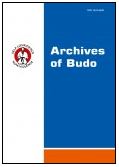2010, Volume 6, Issue 4
Anthropometrical and physiological profiles of the Algerian Olympic judoists
Ramdane Almansba1, Stanislaw Sterkowicz2, Katarzyna Sterkowicz-Przybycień3, D. Mahdad4, R. Belkacem5
1Fedération Algérienne de Judo (FAJ), Maison des Fédérations, El Biar Alger, Algérie, Exercise Physiology Laboratory, Quebec University, Kinesiology, Department, Montreal, Quebec, Montreal Quebec, Canada
2Department of Theory and Methodology of Combat Sports, University School of Physical Education, Cracow, Cracow, Poland
3Chair of Theory and Methodology of Gymnastics, University School of Physical Education, Cracow, Cracow, Poland
4Laboratoire des Adaptations et de la Performance Motrice, INFS-STS Delly Ibrahim, Alger, Alger, Algeria
5Fedération Algérienne de Judo (FAJ), Maison des Fédérations, El Biar Alger, Alger, Algeria
Author for correspondence: Ramdane Almansba; Fedération Algérienne de Judo (FAJ), Maison des Fédérations, El Biar Alger, Algérie, Exercise Physiology Laboratory, Quebec University, Kinesiology, Department, Montreal, Quebec, Montreal Quebec, Canada; email: ram.almansba[at]yahoo.fr
Full text
Abstract
Background and Study Aims: to establish the anthropometrical and physiological characteristics of male and female of the Algerian Olympic judo team.
Material and Methods: Thirteen members of the Algerian judo team, seven males aged 27.14 ± 3.02 years and six females aged of 24 ± 4.14 years.The anthropometrical dimensions were carried out: body weight, 6 height point, 6 breadths, 5 circumferences and 4 skinfold thickness. Body fat was estimated using Durnin and Womersley method. The body composition (BC) Hattori chart was used for the representation of individual percentage fat (PF %), (FFMI), (FMI) (BMI). For physiological tests, were used: Ruffier-Dickson test Power output (PWC170 cycle test). Results in jumping Sargeant test (VJ) was also used for counting power (P) according to Lewis formula.
Results: A sexual dimorphism observed on the morphological variables. Males are higher in two lengths (anterior iliac spine and Acromion-dactylion III points), three breadths (thorax transverse, knee and elbow), and 3 circumferences (thorax, relaxed arm and waist) than females. A significant differences (p<0.05) exists between males and females in body composition (BM, PF%, FFM, FFMI) and RDI. However we didn’t observe a sexual dimorphism in: height and BMI, PWC170 and O2max, VJ and Power.
Conclusions: We must have consider the both components FFMI and FMI to interpret the BMI . The new rules of IJF requires 5 minutes duration in female combat and the golden score proposal in case of combat tie. Thus, it is imperative to increase their O2max for a better performance optimization.
Key words: anthropometry, body composition, heart rate , judo, muscular power, v o2 max




